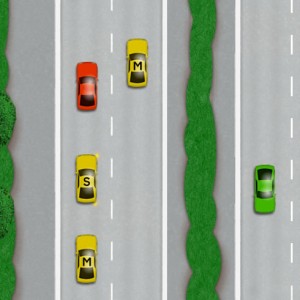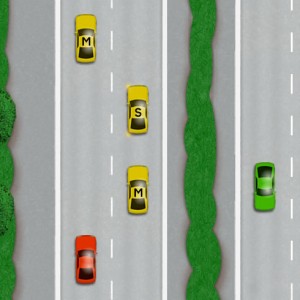Many accidents are caused on motorways due to the incorrect procedure when overtaking. This can be due to not knowing the correct procedure, driving with bad habits or being tired.
Motorways are high speed and have a maximum speed limit of 70mph. Taking risks should be avoided and the correct procedures implemented at all times to minimise the potential of a high speed collision.
This section will cover the correct procedure and rules for overtaking and changing lanes on a motorway for new and experienced drivers.
Overtaking should only be performed if you are sure it is safe and legal to do so. A simple procedure known as the Mirror, Signal, Manoeuvre routine each and every time you wish to overtake is the difference between a potential accident and safety.
Of course, you can’t account for other car drivers bad habits, although driving safely yourself allows you to spot unsafe drivers, giving you the opportunity to avoid them.
Overtaking on a motorway
The diagram shows you as the yellow car about to overtake the red car using the MSM (Mirror, Signal, Manoeuvre) routine.

Before even attempting to change direction, check both your main interior and right side mirror for any vehicles approaching from behind. Car mirrors do not cover all of the field of vision.
Take a look into the right side blind spot before signalling. The blind spot will require you looking briefly over your right shoulder. Ensure that it is clear and there are no vehicles approaching at high speed from behind.
If all clear, signal to the right to allow other to see your intention of changing lanes. It is law that you must signal to the right.
Steer gently to the right into the next available lane to the right and once there, look into your rear view mirror for approaching vehicles and cancel your signal.
Moving back into the left lane
Once you feel there is a safe distance from the red car to enable you to move back into the left lane, look into your interior mirror and left side mirror. If you see the front of the vehicle you wish to overtake in your main interior mirror, you know you have sufficient and safe distance from that vehicle to move back to the left.

To be safe, take a look into the left blind spot to ensure all is clear there; motorbikes can come from know where. Signal to the left, again to let other know of your intentions. It is not mandatory to signal to the left when moving back in, although if the motorway is busy, it’s a good idea to do so.
Once back into the left lane, cancel your signal and once again check the interior mirror to establish all is safe behind.
Once you have finished overtaking, if you feel you are a little too close to a vehicle in-front of you, slowly increase your distance whilst giving regard to vehicles behind. If you are unsure of a safe following distance, the 2 second rule is an easy to follow guide to maintaining a safe following distance.
Overtaking on the left
Overtaking on the left is not only dangerous but generally considered illegal unless under certain conditions. In congested conditions, traffic in adjacent lanes might be traveling at a slower speed to those in left-hand lanes. In this situation, it is acceptable to overtake traffic using the left lane to keep up with traffic in your lane.
Solid white lines
It is not legal to cross a solid white line. If you wish to overtake another vehicle, ensure the line you wish to cross is broken and not solid. See double white line for further information.
GUIDES AND TUTORIALS RELATED TO MOTORWAY DRIVING
- Motorway slip road
- Motorway light signals
- Motorway rules
- Motorway road signs
- Motorway driving
- Motorway reflective studs
